Why is the New York Times dropping its Windows 8 and 10 tablet apps?
3 min. read
Published on
Read our disclosure page to find out how can you help MSPoweruser sustain the editorial team Read more

Four years ago, at the launch of Windows 8 in October 2012, the New York Times proudly launched their Windows 8 app which allowed subscribers to enjoy the full breadth of content available to them from an optimized app, including full articles, videos, photos, slideshows and blogs. The apps featured tiles, which allow users to pin any of the sections and blogs to quickly see the latest headlines at a glance, offline reading and many more features.
At the time Denise Warren, general manager, NYTimes.com and senior vice president and chief advertising officer, The New York Times Media Group, said: “The introduction of these two apps for Windows 8 demonstrates our commitment to bringing our journalism to our readers on the platform of their choice. Whether they are on desktop, laptop or tablet, or they are browsing through the top headlines on the Bing News app, The Times’s journalism will be there to help readers better understand the world they are living in.”
Today subscribers on PCs have been met with the following message:
The New York Times will no longer support the NYTimes app for Windows tablet and desktop. You can access a more complete version of The New York Times through your device’s browser at our website, nytimes.com
The NYTimes website includes the same content as the app, plus interactive articles, expanded video features and richer article content.
It is unlikely that the NY Time’s commitment to “bringing our journalism to our readers on the platform of their choice” has waned over the last 4 years. Much more likely it has never been there in the first instance, and the sunsetting of the app corresponds to Microsoft’s contract with the newspaper running out. This would explain a number of other prominent apps, such as MyFitnessPal and Amtrak dropping off recently also.
On Windows desktop and tablet however the move makes less sense, since by most accounts having 350 million monthly active users in a year should be counted as a success. The truth is however that store apps still have limited uptake, with AdDuplex for example claiming that even Universal Windows Apps see more of their usage on the small 6 million Windows 10 Mobile base rather than the 300 million Windows 10 PC base.
To attract apps in a lasting way to the platform Microsoft needs to reverse this phenomena, with the web being their biggest enemy. Microsoft’s solution, pinning the store to the task bar and advertising apps in the start menu, does not appear to have electrified the app market in any real way on the PC platform yet.
Microsoft needs to do more, be it massive advertising, buying some killer apps, giving away prizes or sacrificing small animals, or else will be relegated to being a simple launch pad for Google’s Chrome browser.
Do our readers have any ideas on how Microsoft could jump-start the app economy on Windows 10? Let us know below.









